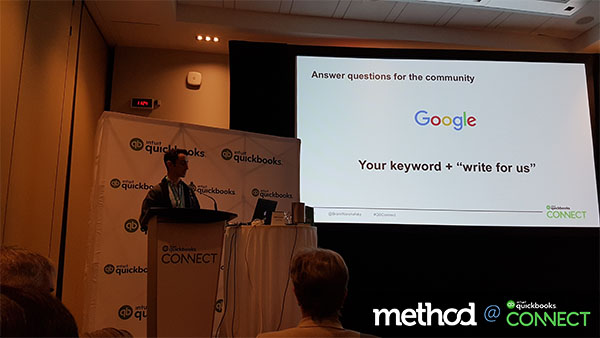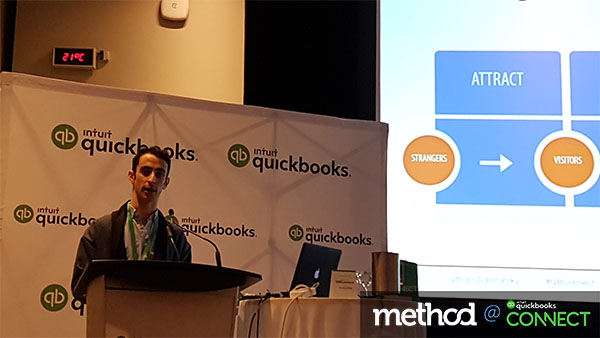There’s no denying that the heyday of traditional outbound marketing has passed.
Even just a decade ago, companies could rely on TV commercials, radio ads, and roadside billboards to reach their target consumers. But consumer behavior has changed.
As entrepreneur Bram Warshafsky pointed out at QuickBooks Connect, many people now watch Netflix instead of TV, listen to Spotify instead of the radio, and walk around looking down at their phones instead of up at the world. The key takeaway for companies: “Good luck advertising to me,” says Warshafsky. Instead, it’s time for modern businesses to focus on reaching consumers in a new way.

That’s where content marketing comes in. Warshafsky explained that the best way to stand out from your competitors is to build a strong brand — and content marketing is the key to brand-building. By creating valuable and relevant content (that isn’t just a sales pitch), you can establish yourself as a trusted resource while building relationships with your target consumers. Not a bad deal.
To help the audience get started on their own content marketing journeys, Warshafsky outlined five key steps.
1. Start By Listening
The first step in creating engaging content is to determine what your audience finds engaging. What are they searching for online? What problems are they trying to solve?
To start off, Warshafsky suggests Googling your main keyword (i.e. the product or service that you sell) along with the word “community.” This will help you identify where your target customers spend time online and what they’re talking about. Browsing online communities like Quora, Reddit, and Yahoo! Answers is another great way to scope out your customers’ pain points.
Finally, don’t forget to listen to what people are telling you about your existing content. If you use Google Analytics for your website, take a look at your exit pages. An exit page is the last page a visitor views before leaving your site entirely. If you notice a trend among all of your website visits, that may be a sign that a particular page isn’t telling people what they want to know.
2. Answer Questions for Your Community
Now that you know what questions your community has, it’s time to start answering them. Again, Warshafsky recommends turning to Google. By searching for your keyword plus “write for us,” you’ll uncover websites that are looking for content on your area of expertise. By publishing guest posts on these sites, you can start to build your brand reputation as well as link back to your own site.

Quora is another great platform for sharing your wisdom. Browse existing questions related to your industry and answer as many of them as you can. Or, if there aren’t any questions that speak to you — “just anonymously ask your own question and then answer it!” suggests Warshafsky. Look at Quora’s analytics to see which of your answers were well-received by the community; this will tell you what to focus on when creating more involved content.
3. Invest in Evergreen Content
You’ll need to invest some time and effort (though not necessarily a ton of money) into creating valuable evergreen content. This is the content that is continually relevant to consumers, rather than being tied to a specific occasion or season.
One of Warshafsky’s favorite types of evergreen content is a short animated explainer video: “You’ll start to find that when you meet with potential customers, they already know about your business.” However, the possibilities for what you can create are endless — videos, blog posts, case studies, ebooks, and more. Put the content on your website and make visitors fill out a form to access it so you can engage with them.
Not sure how to create content around what you do? Warshafsky has the solution. “If your business is kind of boring, consider doing a whiteboard animation. I don’t know why, but everything in this medium is so interesting.”
4. Use Your Blog to Win Long-Tail Keywords
When you create content, it’s important to include keywords that are important to your business. This is what tells search engines to display your content when users search for those keywords. But the more generic and popular a keyword is, the harder it will be for your content to rank in the top search results.
Enter the long-tail keywords. These longer queries are searched for less often, but provide opportunities to create very focused content. As an example, consider the difference between the keywords “CRM” and “CRM that integrates with QuickBooks Desktop.”
Long-tail keywords are great starting points for blog posts. And while “writing a blog is more of a marathon than a sprint,” says Warshafsky, it can turn into a great long-term sales strategy. Of course, not everyone who visits your blog will have a need for what you sell. But the more visitors you attract, the more of them you can eventually convert.
5. Focus on Content Distribution
The final piece of the puzzle is content distribution — making sure your content reaches the people who want it. There are plenty of tools that can help you give your content the best chance of being found. For instance, you can ensure that Google has the most up-to-date view of your site using Search Console, while HubSpot’s Website Grader can help you identify weaknesses in your site.
Next, focus on getting as many eyes on your content as possible. Warshafsky suggests syndicating your posts on Medium and LinkedIn and linking back to your site to build its authority. Your email signature is also a great place to include a link to your latest piece of content.
Finally, you can use social media to distribute your content — but don’t forget about the “social” aspect. Says Warshafsky, “People complain that social media doesn’t drive sales, but that’s not really the purpose of it. The purpose is to be human.” Rather than shouting your business’s merits from the rooftops, focus on truly engaging with your audience. As you build relationships and reputation, the payoff will naturally follow.
Want more #QBConnect content? Check out our full coverage of QuickBooks Connect Toronto 2018!






